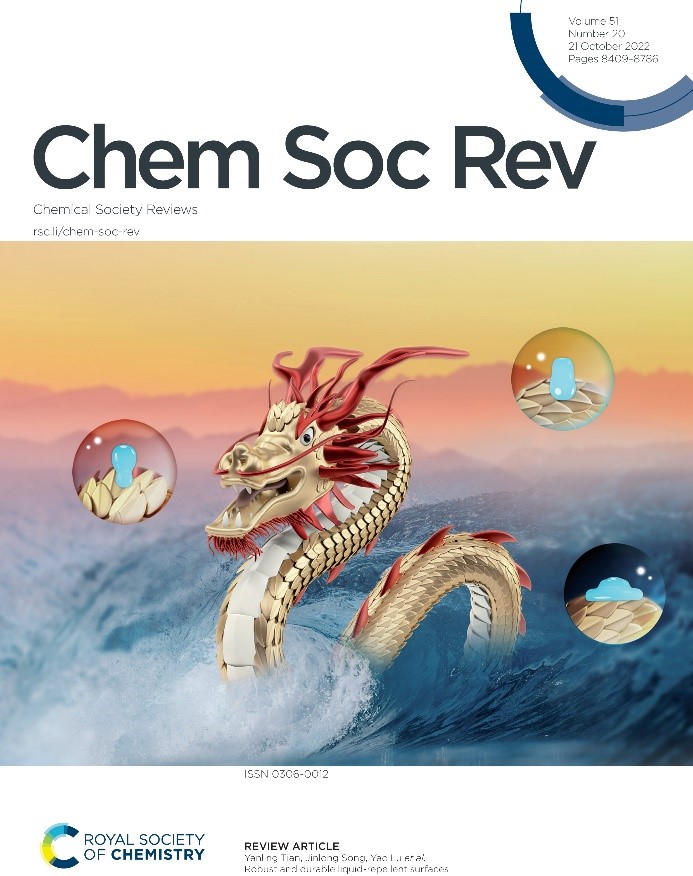Recently, Dr. Faze Chen, a young academic from the School of Mechanical Engineering of Tianjin University, has published a peer-reviewed paper as the first author inChemical Society Reviews, a leading reviews journal of the Royal Society of Chemistry with the latest impact factor of 60.615.

Fig. 1 The paper has been highlighted as the outside front cover ofChemical Society Reviews.
Bio-inspired liquid-repellent surfaces, such as superhydrophobic surfaces, superoleophobic surfaces, and slippery liquid-infused surfaces, have shown great application prospect in liquid-proofing, self-cleaning, anti-icing, anti-corrosion, fluid manipulation, biomedicine, etc. Therefore, these functional surfaces have drawn keen research interest from the communities engaged in bionic manufacturing, micro-nano machining, surface engineering, interfacial chemistry, microfluidic, etc. However, most of these surfaces have poor robustness and durability and would lose their liquid repellence easily under practical conditions, which notably hinders the development of their real-world applications. The past ten years have witnessed rapidly increasing focus on the robustness and durability of liquid-repellent surfaces, and many breakthroughs have been achieved. Based on their own research findings and the publications of other groups, Dr. Chen and co-authors have reviewed the research advances of robust and durable liquid-repellent surfaces.

Fig. 2 Illustration of the main contents of this paper.
Wetting generally involves the spreading of a liquid on a solid/liquid surface and the formation of contact line and contact angle at the triple-phase interface. Wettability can be described by the classical models proposed by Young, Wenzel, and Cassie-Baxter, and can be evaluated by contact angle, contact angle hysteresis, sliding/rolling-off angle, adhesive force, etc. Liquid-repellent surfaces are characterized by non-wetting property and high mobility of liquid droplets deposited on them, that is, the droplets can easily slide- or roll-off from the surfaces without liquid residue. Typical liquid-repellent surfaces can be roughly classified into three main categories: superhydrophobic surface, superoleophobic surface (both in air and under water), and slippery liquid-infused surface. Superhydrophobicity and superoleophobicity in air depend on the air cushions trapped in the micro/nano rough structures, while the liquid repellence of underwater superoleophobic surface and slippery liquid-infused surface rely on the liquid cushion locked by the rough structures.
Durability of liquid-repellent surfaces mainly contains three aspects: thermodynamic, mechanical, and chemical durability. Thermodynamic durability of liquid-repellent surfaces refers to the persistence or recovery of their air or liquid cushions during the development of thermodynamic processes such as diffusion, evaporation, condensation, etc., and it can be evaluated by increasing water hammer pressure, immersing in testing liquids, vapor condensation, droplet evaporation, gravimetric drainage, etc. Mechanical durability implies the ability of liquid-repellent surfaces to withstand the destructions of surface textures and/or chemistries under continuous external force action, and can be tested by tangential abrasion, dynamic impacting, tape peeling, substrate deformation, etc. Chemical durability means the resistance of liquid-repellent surfaces towards various chemical invasions, and its general testing methods include acid/alkaline/salty solutions corrosion, exposure to UV and active species, organic solvents invasion, high/low temperature treatment, etc.
To improve the robustness and durability of artificial liquid-repellent surfaces, various strategies have been proposed to address the thermodynamic durability, mechanical durability, chemical durability, or several aspects of them. First of all, the robustness and durability of the matrix and surface chemistry should be well considered, which can obviously enhance the mechanical and/or chemical durability of liquid-repellent surfaces. Next, various special surface textures, such as re-entrant microstructures, densely and closely packed nanostructures, self-similar rough structures, hierarchical micro/nano structures, etc., have been designed to improve the robustness and durability of liquid-repellent surfaces from different aspects. For those substrates covered with liquid-repellent coatings, increasing the bonding strength among them via covalent bonding, cross-linking, or adhesive layer is a universal and effective strategy. In addition, imparting liquid-repellent surfaces with self-healing property, such as self-healable surface chemistry, restorable micro/nano structure, or both, is another alternative method to improve their durability. Moreover, selective combination of the proposed strategies have been recently demonstrated to be more effective in further improving the robustness and durability of liquid-repellent surfaces, which should be a promising solution for moving liquid-repellent surfaces towards real-world applications.
Then the paper briefly discusses several typical applications of liquid-repellent surfaces, such as anti-corrosion, anti-fouling, ice-phobicity, liquid/gas harvesting/transport/manipulation, immiscible liquids separation, electricity generation, and enhanced heat transfer, and special emphasis is put on the importance of robustness and durability of these surfaces. Finally, potential research perspectives in robust and durable liquid-repellent surfaces are proposed, such as optimization of the characterization methods of liquid repellence, selection and standardization of the evaluation methods for robustness and durability, optimization and combination of the existing strategies to further enhance the durability, improvement and industrialization of the preparation methods of liquid-repellent surfaces, etc.
This review will draw great attention from researchers engaged in functional surfaces fabrication, especially those in bionic manufacturing, micro-nano machining, surface engineering, chemical synthesis, etc., and may also appeal to those communities that are devoted to promoting commercial applications of liquid-repellent surfaces in our daily lives.
Dr. Chen is a fixed member of the International Joint Research Center for Micro/Nano Manufacturing and Equipment established by Prof. Dawei Zhang at the School of Mechanical Engineering of TJU. Dr. Chen’s research interests focus on the preparation and application of micro/nano structured functional surfaces, laser-based micro-additive/subtractive manufacturing, etc. He has received grants from the Pioneer Project of Ministry of Science and Technology of China, National Natural Science Foundation of China, National Postdoctoral Program for Innovative Talents, etc. He has already published more than 40 peer-reviewed papers that are indexed by SCI, includingChemical Society Reviews,Advanced Functional Materials,Chemical Engineering Journal,International Journal of Machine Tools and Manufacture, etc.
This 108-page paper of nearly 73,000 words was completed based on the review and summary of more than 750 references, and has been highlighted as the outside front cover ofChemical Society Reviews.
For more details, please go to Faze Chen, Yaquan Wang, Yanling Tian*, Dawei Zhang, Jinlong Song*, Colin R. Crick, Claire J. Carmalt, Ivan P. Parkin, Yao Lu*. Robust and Durable Liquid-Repellent Surfaces.Chemical Society Reviews, 2022, 51, 8476-8583.
Links:https://doi.org/10.1039/D0CS01033B.
By: School of Mechanical Engineering
Editor: Qin Mian






